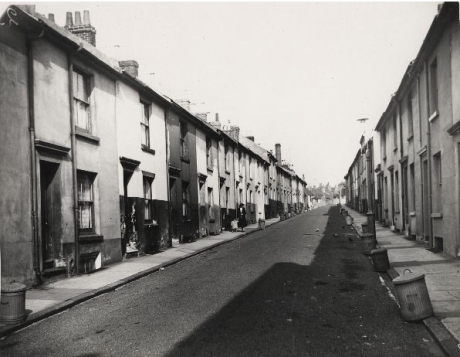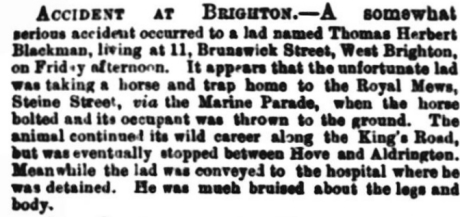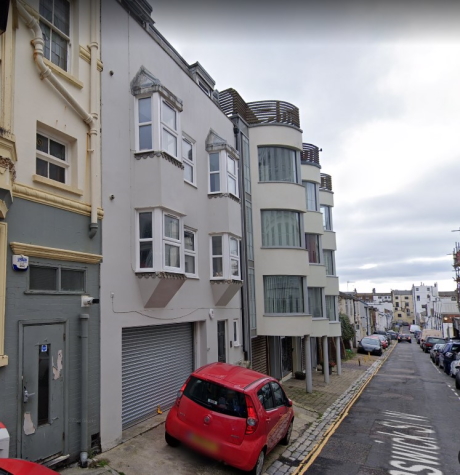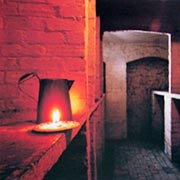67 Brunswick Street West
For most of the period of our study from the building of Brunswick town in the 1820s to the 1920s, this building was number 32 Brunswick Street West, being at the back of 32 Brunswick Square.
Unlike the stables that serve most of the houses on the west side of Brunswick Square, the stable for number 32 is detached from the main house and is connected by a path between the two. The fact that the stables are unconnected may help to explain why they frequently don’t appear in the census returns; it seems that the enumerator often assumed that the grooms and coachmen residing in the stables would be counted in the attached main houses in Brunswick Square.

Stables in Brunswick Street West and the path connecting them to 32 Brunswick Square
In 1895 the properties associated with 32 Brunswick Square are transferred from the Whitlark to Herries family where they remained until 1918.
The Trade Directories rarely mention the stables either as the residents wouldn’t have paid to be in the directory and the building didn’t represent a major shop or service which would have been of interest to the general public.
Over the course of its existence from the 1820s to 1920s the following residents are found in the censuses:
1841 Samuel Mewett
In 1841, the census finds 10 unoccupied properties and only one coachman on the east side of the street. There are no building numbers but Samuel Mewett, Coachman, appears first on the east side at the top of the street so he may be living in number 32 in our street.
There is no mention of Samuel in any of the documents relating to 32 Brunswick Square which is not unusual. None of the census returns for the main house list any coachmen or grooms so it’s possible that Samuel was paying a rent to the owners/leaseholders of No.32 to carry on a business that serviced more than just that one house.
Samuel was living with his wife, Mary, and her mother, plus six children in the four rooms above the stable.
Samuel Mewett was born about 1801 in Newhaven, Sussex and was, presumably, persuaded to move to the Brighton and Hove area by the building boom of the 1820s with Kemp Town and Brunswick Town being developed
Following their time in our street, Samuel and his family moved to 14 Upper North Street by 1846 where the Poll Books show Samuel, being the only one who could vote, until 1853. He’s described as a Fly Proprietor in the 1851 census so he seems to have been an enterprising businessman. He lived in Brighton until the age of 68. A fly would have been similar to this Hansom Cab:

A London Hansom Cab in 1877
Our building doesn’t get a mention in the census for the next three decades, possibly because the enumerator expects it to be included in Brunswick Square. The stables for number 32 Brunswick Square appear not to be used by the owners of 32, the Lewis family, for the period of their occupation from 1846 to 1895. There are no mentions of residents of the stables or of horse management staff in the main house between 1841 and 1881. However, between 1856 and 1870, the poll books show the stables as being in the occupation of Lady Hotham, presumably leased by her for her own use.
1881 Henry Waller
By 1881, Henry Waller is living here with his wife, Elizabeth, and three children – a massive improvement on the overcrowding in 1841.
Henry was born about 1836 in Ditchling, Sussex and by 1871 he was employed as a coachman and living in 36 Ashton Street, Brighton. There were no stables in that part of town so he must have been employed elsewhere.

Ashton Street in the 1950s prior to demolition (James Gray Collection)
His wife in 1871 was Matilda and they were living there with Matilda’s son from a previous marriage and her granddaughter. Presumably, Matilda’s husband had died in the previous decade and she had remarried. Matilda, herself, died in 1877 at the age of 36 leaving Henry to remarry. Life, it seems, was quite fragile in the 1800s.
As he’s living at 32 Brunswick Street West, it’s likely that he was working for the owners of 32 Brunswick Square, the Independent Widow Lady, Elizabeth Mackay, who had four other servants with her in the main house.
1891 Herbert Blackman
In 1891, Herbert Blackman is living in number 32 with his wife, Jane, and four of his children. Several of his previous children had already left home. He was described as a Coachman domestic servant so it’s likely he was working for the family in the main house. Herbert was born in Wadhurst, Sussex about 1834 and like lots of people from outside the towns and cities, his father was an agricultural labourer. Working as a coachman for a wealthy family would have been a step up the social ladder for him.
By the age of 16 in 1851, Herbert is working on a farm looking after stock in Wadhurst. Presumably, in search of a better life, he’d moved to Brighton by the 1860s where he married Jane Stops in 1868. They started a family shortly after getting married and following the birth of two girls, the first son, traditionally named Herbert after the father, was born in Patcham in 1872. The family were living over stables in Patcham in 1881 where Herbert senior was already a domestic coachman.

The Brighton Gazette of 1st February 1886 reported that a lad of 14 years old by the name of Herbert Blackman of Brunswick Street West was involved in an accident. Herbert, it seems, was already following his father in the business of transport and was taking a horse and trap home to the Royal Mews, Steine Street via Marine Parade. The horse bolted in Burlington Street and Herbert held on all the way along the seafront road into Brighton and was finally thrown off just past West Street. The animal continued its wild career along the King’s Road but was eventually stopped miles away between Hove and Aldrington. Meanwhile, the lad was conveyed to hospital by P.C. Ratcliffe where he was detained with bruised legs and body.
After losing his wife in 1899, Herbert senior moved to 4 Farm Road, Hove by 1901 and, at the age of 66, was still employed as a domestic coachman. He was living with two of his daughters, Mary a domestic servant and Florence, a pupil teacher in a church school. Florence was only 14 years old but was clearly helping out with teaching other pupils.
Herbert moved in with his sister in Preston, Brighton by 1911 before dying at the age of 77.
1901 and 1911 George Castle
George Castle (Casttle) age 49 is a domestic coachman from Hampshire here in 1901 and 1911. Interestingly, in the main house at the same time is William Galeton, a single 28-year-old groom domestic from Lymington, Hampshire. This would suggest that the residents of the main house are still making use of horse transport in 1901. They’ve found room in the main house for the groom and, for now, there are only George, the coachman, and his wife living above the stables.
George Castle was born about 1852 in Sutton Scotney, Hampshire to Charles, an agricultural labourer, and mother Elizabeth.
He’s involved with looking after horses by 1871 as he features in a police report in the Hampshire Advertiser of 27 September. A George Gale was charged with stealing five large onions from the stable of George Castle, an ostler (someone who looks after horses, often for an Inn) of the Coach and Horses, Sutton Scotney.
A few years later in 1875, he marries Charlotte Cashman from the same village. The marriage takes place in Winchester. Unusually, Charlotte is about 12 years older than George.
He’s recorded as being a coachman, still in Hampshire, in the 1891 census and still with Charlotte.
They move to Sussex but Charlotte dies in 1906.

The Street Directories show George in Brunswick Street West from 1910 to 1919 and the 1911 census records him and his new wife Emily Eva, some 16 years younger than him, and her son from a previous marriage, all living in number 32. He’s employed as a Domestic Coachman and his employer is described as a Gentleman, presumably the owner of the main house. The Poll Books show that in 1912, George is entitled to vote by virtue of his association with a qualifying property, namely 32 Brunswick Square.
George appears to have been the last person in number 32 employed to look after horses. The second decade of the 1900s marks the start of a change from horse-drawn transport to the use of cars, only for the wealthy to begin with, though.
1921 Samuel George White
Samuel George White is at number 32 in the 1921 census. He is a Grocer Manager employed at White & Son’s Grocers of 42 Western Road, Hove. He’s 64 and living with his wife, sister and daughter. It’s possible he was living above the stable or, with the building no longer used for horses, he may have converted the downstairs.
Samuel was born in Hampshire but moved to Sussex in time to marry Florence Mary Hammett in Brighton in 1879. He became a grocer’s assistant and was living in Western Road, Brighton with his family by 1901. By the next census in 1911 he was no longer an assistant but was running his own grocery while living in 41 Osborne Villas, Hove.
1925 Arthur Edward Hooke
The street numbers changed around 1924 to 1925 and 32 became 67.
The electoral roll shows Arthur Edward Hooke and his wife living here in 1925.
Arthur was born and worked in Birmingham where, in 1911, Arthur gave his occupation as Motor Engineer and, in 1921, as Marine Motor Engineer. He was carrying out his profession in Birmingham until 1922 when he had moved to 64 Brunswick Street West, just down the road from number 67. We can only assume that he continued the same type of profession from number 67 Brunswick Street West.

Number 67 as a garage in the 1975 Hove Borough Council Conservation Area photographic record
The above image was taken before the building’s later conversion to flats and may resemble what it looked like in the 1920s

Number 67 in 2020 from Google Streetview
Research by Kevin Wilsher, 2022
Return to Brunswick Street West page.



